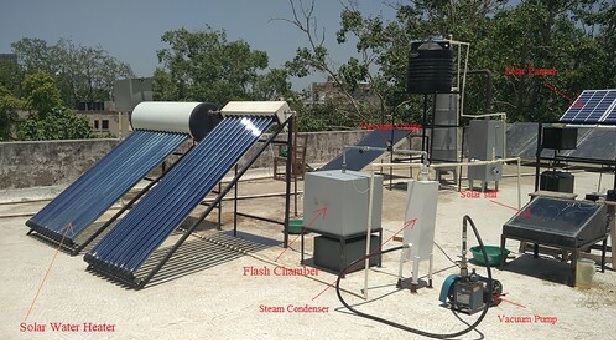Recently, researchers at the Indian Institute of
Science (IISc) have developed a siphon-powered thermal desalination system that
can transform salty seawater into clean drinking water faster, cheaper and more
reliably than existing methods.
Thermal Desalination System
¨
A thermal desalination
system that leverages the principle of siphonage to continuously draw seawater,
enabling its evaporation and subsequent condensation into potable water.
Key Challenges of Traditional Solar Stills
¨
Salt Accumulation: During
the evaporation process in traditional solar stills, salt present in seawater
crystallizes and deposits on the heated evaporator surfaces. This salt
accumulation forms crusts that obstruct water flow, significantly diminishing
the effective evaporation area.
¨
Capillary Wicking
Limitations and Scaling Constraints: Solar stills use wicking materials to move
saline water to the evaporation surface, but their limited lifting height
(10–15 cm) restricts system scale and water output per stage.
Siphon
¨
A siphon is a device that
allows the transfer of a fluid from one reservoir to a second at a lower level
even though the first part of the journey is up-hill.
A siphon is effectively an inverted U-tube with
unequal length tubes.
Technology and Working Principle of Siphon
Desalination System
¨
Composite Siphon
Mechanism: The core component of the system is a composite siphon which is
consisting of a fabric wick combined with a grooved metallic surface.
¨
The fabric wick draws
saline water from the reservoir, while gravity facilitates a continuous and
steady flow, effectively flushing away salt deposits before they can
accumulate.
¨
Thin Film Evaporation and
Condensation: The water is distributed as a thin film across the heated
metallic surface, where it undergoes evaporation. The resulting vapor then
condenses on a proximate cooler surface positioned just two millimetres apart.
¨
Enhanced Efficiency via
Ultra-Narrow Air Gap: The ultra-narrow air gap greatly improves thermal
efficiency of the system. It enables production of over 6 litres of potable
water per square metre per hours, several times higher than conventional solar
stills.
Advantages of the Siphon-Powered Thermal
Desalination System
¨
Multistage heat
recycling: By stacking multiple evaporator-condenser pairs, the system recycles
heat repeatedly, maximizing output from solar energy.
¨
Salt resistance: The
siphon flushes salt before crystallization, enabling the system to handle
highly saline water up to 20% salt concentration, including brine.
¨
Low cost and scalability:
Made of simple materials like aluminium and fabric, the system is affordable
and scalable.
¨
Sustainability: It runs
on solar energy or waste heat, well-suited for off-grid communities, disaster
zones, and arid coastal regions.
¨
Drinking Water for
water-stressed regions: It could help secure safe drinking water for millions
in water-stressed regions. From small villages to island nations, the siphon-powered
desalination system may finally make the ocean a dependable source of fresh
drinking water.




